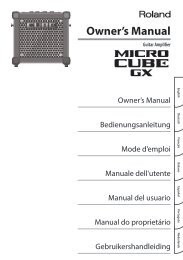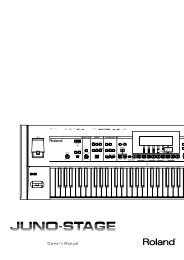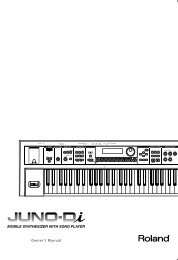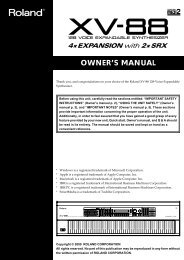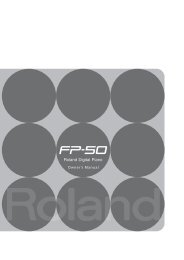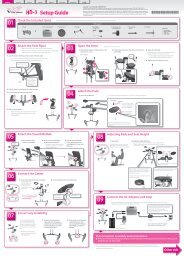You also want an ePaper? Increase the reach of your titles
YUMPU automatically turns print PDFs into web optimized ePapers that Google loves.
XY mode<br />
Chapter 3. About the D-FIELD<br />
Changing the brightness of the sound/Adding character to the sound (FILTER)<br />
You can vary the brightness of the current part by the location of your touch. Left/right movement will vary the cutoff<br />
frequency. Upward movement will apply more emphasis to the region surrounding the cutoff frequency (resonance),<br />
producing a distinctive tone.<br />
Display Explanation Setting<br />
TYPE Select the type of filter.<br />
* At the factory<br />
settings, the filter<br />
will be as specified<br />
by the patch<br />
selected for the<br />
current part of the<br />
current pattern.<br />
* For some waveforms, you may hear no sound at all if you move your finger far<br />
toward the right.<br />
X none Cutoff Frequency<br />
PKG (Peaking Filter):<br />
Moving your finger toward the right will increasingly emphasize the high frequency<br />
range. Moving your finger toward the left will increasingly emphasize<br />
the lower frequency range.<br />
Cutoff Frequency (fixed)<br />
Y none Resonance Resonance (fixed)<br />
➔ Changing the D-FIELD settings (p. 22)<br />
Applying special effects to the sound (MFX)<br />
You can simultaneously control any two desired parameters of a multi-effects (p. 44).<br />
* There will be no effect if [MFX] is dark. Press [MFX] to make it light.<br />
Display Explanation Setting<br />
TYPE Select the multi-effects type. Refer to “Available Settings” (p. 44).<br />
X Select the parameter that will be affected<br />
when you move your finger to left or<br />
right.<br />
Y Select the parameter that will be affected<br />
when you move your finger upward or<br />
downward.<br />
➔ Changing the D-FIELD settings (p. 22)<br />
While setting X or Y, you can hold down the D-FIELD function button [MFX] and press one of the part buttons to turn the Part<br />
MFX Switch (p. 19) on/off. The part button will light to indicate parts for which the multi-effects is on.<br />
Making detailed settings<br />
1. Hold down the D-FIELD function button [MFX], and press [EDIT].<br />
2. Press [ENTER] to select the desired parameter.<br />
OFF:<br />
The filter will not be applied.<br />
LPF (Low Pass Filter):<br />
Moving your finger toward the right will cause the sound to become increasingly<br />
closer to the original waveform, and be brighter. Moving your finger toward<br />
the left will increasingly cut the higher frequencies, making the sound darker.<br />
* For some waveforms, you may hear no sound at all if you move your finger far<br />
toward the left.<br />
BPF (Band Pass Filter):<br />
Moving your finger toward the right will increasingly cause only the high frequency<br />
range to be heard. Moving your finger toward the left will increasingly<br />
cause only the low frequencies to be heard.<br />
HPF (High Pass Filter):<br />
Moving your finger toward the right will increasingly cut the lower frequencies,<br />
sharpening the sound. Moving your finger toward the left will cause the sound<br />
to become increasingly closer to the original waveform.<br />
Refer to the explanation for each effect (pp. 45–57).<br />
* When you change the type, the parameter whose value is<br />
followed by an “X” or “Y” will be selected automatically (X =<br />
left/right, Y = up/down).<br />
* It is not possible to select the same parameter for both X and Y.<br />
3. Turn [VALUE] to change the setting.<br />
For details on the parameters and their settings, refer to the explanation for each effect (pp. 45–57).<br />
33<br />
Chapter 3



